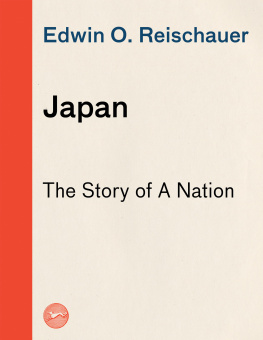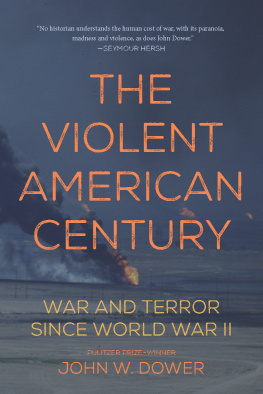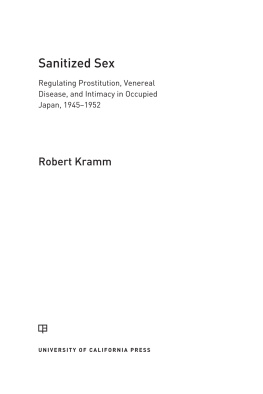
Copyright 1986 by John W. Dower
All rights reserved under International and Pan-American Copyright Conventions. Published in the United States by Pantheon Books, a division of Random House,
Inc., New York, and simultaneously in Canada by Random House of Canada Limited, Toronto. Originally published in hardcover by Pantheon Books, a division of Random House, Inc., in 1986.
LIBRARY OF CONGRESS CATALOGING-IN-PUBLICATION DATA
Dower, John W.
War without mercy.
Bibliography: pp.
1. World War, 19391945Pacific Area.
2. World War, 1939-1945Public opinion.
3. Racism. I. Title.
D767.9.D69 1986 940.53 85-43462
eISBN: 978-0-307-81614-6
v3.1
For
KANA, RISA , and KEN
CONTENTS
PREFACE
S ome five years ago, while drafting the opening chapter to a projected book about the occupation of Japan that followed World War Two, I found myself mentioning in passing the race hates and merciless fighting that had been so conspicuous in the war in Asia and the Pacific. One of the impressive features of the occupation, after all, was that the defeated Japanese and victorious Allies, predominantly Americans, worked together so amicably and constructively. War-crimes trials were conducted after Japans surrender; reports of wartime atrocities preoccupied journalists and jurists for many months; and there was hardly a corner of Japanese society that was not subjected to critical scrutiny. The war hates themselves, however, seemed to disappear almost overnightso quickly, in fact, that they are easily forgotten now.
In a world that continues to experience so much violence and racial hatred, such a dramatic transformation from bitter enmity to genuine cooperation is heartening, and thus the fading memories of the war pose a paradox. It is fortunate that people on all sides can put such a terrible conflict behind them, but dangerous to forget how easily war came about between Japan and the Western Allies, and how extraordinarily fierce and Manichaean it was. We can never hope to understand the nature of World War Two in Asia, or international and interracial conflict in general, if we fail to work constantly at correcting and re-creating the historical memory. At a more modest level, the significance of the occupation of Japan and postwar rapprochement between the Japanese and their former enemies can only be appreciated against the background of burning passions and unbridled violence that preceded Japans surrender in August 1945. The importance of remembering that visceral level of the war was what prompted my passing reference in that old draft manuscript on the occupation.
The casual mention of race hates seemed too abrupt to stand without elaboration, however, and my attempt to clarify what this meant marked the genesis of the present book. What occurred next may seem agonizingly familiar to many other historians. The passing comment was expanded to a paragraph, which grew into a section, then became a separate chapter, and finally emerged as a major research project in and of itself. This book is a summing up of some of the places to which this little elaboration has ledthus far. Meanwhile, the study of occupied Japan still sits unfinished on the shelf.
This is not the tidiest way to do history, but it is satisfyingfor the problem arose naturally, more as a question than a thesis, and unfolded in unanticipated directions. To understand how racism influenced the conduct of the war in Asia has required going beyond the formal documents and battle reports upon which historians normally rely and drawing on materials such as songs, movies, cartoons, and a wide variety of popular as well as academic writings published at the time. In some academic circles these are not respectable sources, and they are certainly difficult to handle. But they are invaluable for re-creating the ethos which underlay the attitudes and actions of men and women during these years. The greatest challenge has not been to recall the raw emotions of the war, however, but rather to identify dynamic patterns in the torrent of war words and graphic imagesand to bring such abstractions to earth by demonstrating how stereotyped and often blatantly racist thinking contributed to poor military intelligence and planning, atrocious behavior, and the adoption of exterminationist policies. Beyond this lay a further challenge: to explain how the contempt and hatred of the war years could have been dissipated so easily.
Because distorted perceptions and unrestrained violence occurred on all sides, the Pacific War also provides an excellent opportunity to look at racism and war comparativelyand, as the reader will discover, historically. Eventually, the exegesis on a passing comment led to an examination of perceptions of Self and Other in conflicts between white and colored peoples dating back to the fifteenth century. At the same time, it became apparent that many of the idioms of race, on both the Western and the Japanese sides, are best understood in a larger context of hierarchical and authoritarian thinking. In the war in Asiaand in generalconsiderations of race and power are inseparable. As it turned out, much that may at first glance appear to be unique in the clash between Japan and the West in the early 1940s was, on the contrary, familiar in practice and formulaic in the ways it was expressed. And much of the explanation of how race hate gave way to an inequitable but harmonious relationship between victors and vanquished lies in appreciating the malleability of political language and imagery in general.
In pursuing the meaning of race hate in such a variety of directions, I have incurred many personal debts. Several are outstanding. Takako Kishima provided invaluable assistance in assembling materials pertaining to Japanese perceptions of themselves and others during the war, and some of the ideas in the Japan chaptersmost notably the symbolic wartime use of the Momotar folktaleemerged out of discussions with her. Tom Engelhardt, a friend since student days, proved the best of friends as the editor of this manuscript, for he was severe in his critical comments and generous with his time. Several major sections of the present text were completely revised, or written from scratch, in response to his questions and suggestions. Herbert Bix, who has frequently made me rethink Japanese history, called my attention to the recently discovered secret Japanese government study which became the basis of . I was able to explore the world of wartime Japanese cartoons through the generosity of Rinjir Sodei, who allowed me to copy his collection of wartime issues of the magazines Manga and Osaka Puck. In the time-consuming task of tracking down pertinent materials from the English-language media and other library resources, I was ably assisted by Julie Bogle and Ken Munz. Yoko Yasuhara provided me with some requested archival materials from Washington.
Over the years, many individuals offered references, suggestions, critical comments, and assistance of one sort or another which also left a mark on the final manuscript. For such help I am grateful to Thomas Archdeacon, Sonja Arntzen, David Bordwell, Paul Boyer, William Brown, Roger Daniels, Daniel Doeppers, Susan Friedman, Mikiso Hane, Milan Hauner, Draper Hill, J. Vernon Jensen, Sandy Kita, Stanley Kutler, Yusheng Lin, Edward Linenthal, James Lorence, Genji kubo, Eric Van Young, Chieu Vu, and Morio Watanabe. Fred Wiemer saved me from several errors with his careful copy editing. For clerical help, I am indebted, again, to Julie Bogle, as well as Karen Delwiche, Catherine Ganshert, Sandra Heitzkey, Kathleen Kisselburgh, and the office staff in general in the Department of History in Madison. Although the end notes reveal my academic debts, it seems appropriate to acknowledge here in one place those authors whose work on racism or the war in Asia has been especially suggestive. Readers who wish to place this present study in an appropriately broader context will find much of interest in the writings of Louis Allen, John Costello, Roger Daniels, George De Vos, Richard Drinnon, Stephen Jay Gould, Sabur Ienaga, Akira Iriye, Stuart Creighton Miller, Richard Minear, Ben-Ami Shillony, Ronald Spector, Christopher Thorne, John Toland, and Hiroshi Wagatsuma.












